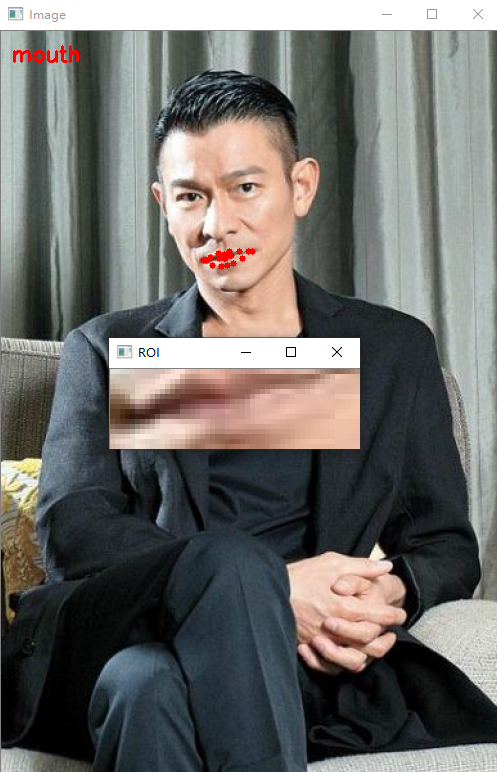detect_face_parts.py:
#导入工具包 from collections import OrderedDict import numpy as np import argparse import dlib import cv2 #https://ibug.doc.ic.ac.uk/resources/facial-point-annotations/ #http://dlib.net/files/ # 参数 ap = argparse.ArgumentParser() ap.add_argument("-p", "--shape-predictor", required=True, help="path to facial landmark predictor") ap.add_argument("-i", "--image", required=True, help="path to input image") args = vars(ap.parse_args()) FACIAL_LANDMARKS_68_IDXS = OrderedDict([ ("mouth", (48, 68)), ("right_eyebrow", (17, 22)), ("left_eyebrow", (22, 27)), ("right_eye", (36, 42)), ("left_eye", (42, 48)), ("nose", (27, 36)), ("jaw", (0, 17)) ]) FACIAL_LANDMARKS_5_IDXS = OrderedDict([ ("right_eye", (2, 3)), ("left_eye", (0, 1)), ("nose", (4)) ]) def shape_to_np(shape, dtype="int"): # 创建68*2 coords = np.zeros((shape.num_parts, 2), dtype=dtype) # 遍历每一个关键点 # 得到坐标 for i in range(0, shape.num_parts): coords[i] = (shape.part(i).x, shape.part(i).y) return coords def visualize_facial_landmarks(image, shape, colors=None, alpha=0.75): # 创建两个copy # overlay and one for the final output image overlay = image.copy() output = image.copy() # 设置一些颜色区域 if colors is None: colors = [(19, 199, 109), (79, 76, 240), (230, 159, 23), (168, 100, 168), (158, 163, 32), (163, 38, 32), (180, 42, 220)] # 遍历每一个区域 for (i, name) in enumerate(FACIAL_LANDMARKS_68_IDXS.keys()): # 得到每一个点的坐标 (j, k) = FACIAL_LANDMARKS_68_IDXS[name] pts = shape[j:k] # 检查位置 if name == "jaw": # 用线条连起来 for l in range(1, len(pts)): ptA = tuple(pts[l - 1]) ptB = tuple(pts[l]) cv2.line(overlay, ptA, ptB, colors[i], 2) # 计算凸包 else: hull = cv2.convexHull(pts) cv2.drawContours(overlay, [hull], -1, colors[i], -1) # 叠加在原图上,可以指定比例 cv2.addWeighted(overlay, alpha, output, 1 - alpha, 0, output) return output # 加载人脸检测与关键点定位 detector = dlib.get_frontal_face_detector() predictor = dlib.shape_predictor(args["shape_predictor"]) # 读取输入数据,预处理 image = cv2.imread(args["image"]) (h, w) = image.shape[:2] width=500 r = width / float(w) dim = (width, int(h * r)) image = cv2.resize(image, dim, interpolation=cv2.INTER_AREA) gray = cv2.cvtColor(image, cv2.COLOR_BGR2GRAY) # 人脸检测 rects = detector(gray, 1) # 遍历检测到的框 for (i, rect) in enumerate(rects): # 对人脸框进行关键点定位 # 转换成ndarray shape = predictor(gray, rect) shape = shape_to_np(shape) # 遍历每一个部分 for (name, (i, j)) in FACIAL_LANDMARKS_68_IDXS.items(): clone = image.copy() cv2.putText(clone, name, (10, 30), cv2.FONT_HERSHEY_SIMPLEX, 0.7, (0, 0, 255), 2) # 根据位置画点 for (x, y) in shape[i:j]: cv2.circle(clone, (x, y), 3, (0, 0, 255), -1) # 提取ROI区域 (x, y, w, h) = cv2.boundingRect(np.array([shape[i:j]])) roi = image[y:y + h, x:x + w] (h, w) = roi.shape[:2] width=250 r = width / float(w) dim = (width, int(h * r)) roi = cv2.resize(roi, dim, interpolation=cv2.INTER_AREA) # 显示每一部分 cv2.imshow("ROI", roi) cv2.imshow("Image", clone) cv2.waitKey(0) # 展示所有区域 output = visualize_facial_landmarks(image, shape) cv2.imshow("Image", output) cv2.waitKey(0)
效果:



